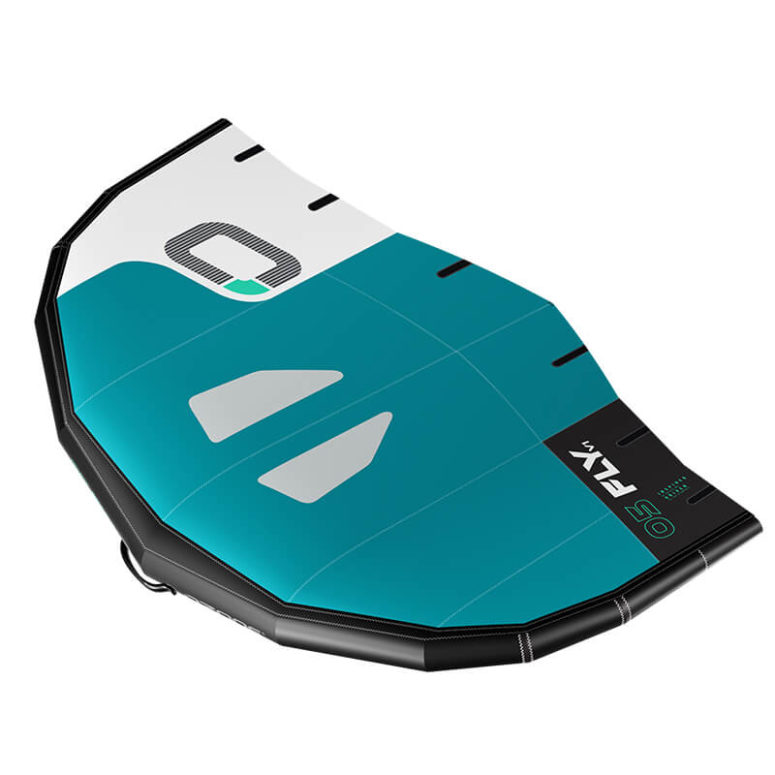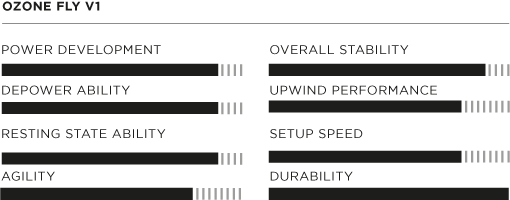

When you purchase gear through links on our site, we may earn a small commission. Here’s why you can trust our tests and our affiliate partner.

Ozone boldly entered the wing game early and firmly with the original WASP presented as one of the first available, and have now developed their range into three distinct models with WASP V3 covering performance freeride and the upcoming Flux V1 handling the high-end race segment. Ozone have focused the Fly V1 as their entry-level wing, with simplicity and ease of use as the primary goals, but from our testing, it’s a wing that shouldn’t be underestimated.
Ozone have historically utilized their own proprietary OZ-CAD software for kite design, and after considerable time and effort they’ve developed a wing-specific module, adapting the software to cope better with the differing loads, stresses and design requirements of inflatable wings. The Fly V1 is among the first products released to market derived from this.
Shape-wise, it’s a low aspect affair with extended middle strut, a compact span wing with a mid-level of dihedral. Handles are fairly long, soft webbing loops which prove very comfortable and easy to find the sweet spot upwind and downwind, minimizing fatigue. The front nose handle bridges the gap between comfort and control well when flagged, allowing a little flex but enough control to correct the wing if it wanders off angle, which in practice it doesn’t very often. Twin Boston valves on the strut and leading edge handle inflation, with pressures varying dependent on the size so it’s worth a glance at the chart, with our 5m requiring 7PSI in the front tube and 8PSI in the strut, providing a respectable tight and rigid air frame. The bag provided is a simple and lightweight stuff sack with a single strap and roll top. There’s some nice detail in the strap, which is padded for carrying your foil on your shoulder comfortably. As standard the Fly comes with a waist leash, while a decent sturdy buckle and wrist leash option is available as an optional extra at a relatively low cost alongside a quick release system. As a bonus there’s a comprehensive repair kit hidden in the bag with color-matched materials and bladder repair patches.
For a lower aspect wing, the upwind angle is respectable, and it likes to push forward with speed rather than downwind as you’d perhaps expect from its shape. Windows are well placed, and made from a lighter more flexible material than most brands. Water also seems to bead off them impressively, so you’re treated to a HD level of vision through them. When raised overhead, there’s no annoying downforce on tacks and jibes when the wing is high. Pumping up onto foil is a simple affair with a slow cadence required and plenty of low-end grunt on tap. Once on foil, the ease of use is apparent; the Fly takes a gust well again transferring the power into forward speed rather than downwind drag, smoothing the whole user experience. Unlike some lower aspect wings, it doesn’t build fatigue in your arms; you can happily cruise around on it for long periods without wishing you’d put a harness on. The compact shape avoids any tip catch, often the folly of beginner wingers.
The quality of the build from Ozone is noteworthy, they are certainly no strangers to manufacturing inflatable structures and have their own bespoke solar-powered factory in Vietnam, renowned for a very consistent and sturdy product. Their long history manufacturing inflatable kites proceeds them, and the stitching and seaming is meticulous as well as the material selection, surpassing most of what we see across the market.
Whilst squarely aimed at the beginner market, the Fly V1 is a wing that shouldn’t be overlooked to the bulk of riders. Its ease of use and amiable, friendly nature will be an asset to any level of winger pushing easily into your higher intermediate stages with xero fuss. It’s light to handle, efficient, minimal and extremely sturdy, with far more performance than you’d expect, particularly in terms of running on the front handle in waves. Its simple to initiate on and off power characteristics, and high levels of stability made it a wing we would happily grab particularly when the conditions look dubious, as you know it’s going to handle it with grace.
